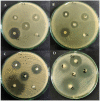Phytochemical Characterization and Antimicrobial Activity of Several Allium Extracts
- PMID: 37241721
- PMCID: PMC10222200
- DOI: 10.3390/molecules28103980
Phytochemical Characterization and Antimicrobial Activity of Several Allium Extracts
Abstract
Microbial infections affect both the human population and animals. The appearance of more and more microbial strains resistant to classical treatments led to the need to develop new treatments. Allium plants are known for their antimicrobial properties due to their high content of thiosulfinates, especially allicin, polyphenols or flavonoids. The hydroalcoholic extracts of six Allium species obtained by cold percolation were analyzed regarding their phytochemical compounds and antimicrobial activity. Among the six extracts, Allium sativum L. and Allium ursinum L. have similar contents of thiosulfinates (approx. 300 μg allicin equivalents/g), and the contents of polyphenols and flavonoids were different between the tested species. The HPLC-DAD method was used to detail the phytochemical composition of species rich in thiosulfinates. A. sativum is richer in allicin (280 μg/g) than A. ursinum (130 μg/g). The antimicrobial activity of A. sativum and A. ursinum extracts against Escherichia coli, Staphylococcus aureus, Candida albicans and Candida parapsilosis can be correlated with the presence of large amounts of thiosulfinates. Both extracts have shown results against Candida species (inhibition zones of 20-35 mm) and against Gram-positive bacteria, Staphylococcus aureus (inhibition zones of 15-25 mm). These results demonstrate the antimicrobial effect of the extracts and suggest their use as an adjuvant treatment for microbial infections.
Keywords: Allium; allicin; antimicrobial activity; phytochemical analysis.
Conflict of interest statement
The authors declare no conflict of interest.
Figures



References
-
- Banik A., Abony M., Zerin T., Datta S. Antibacterial Activity of Allium Sativum, Syzygium Aromaticum, and Cinnamomum Zeylanicum against Food Borne Pathogens in vitro. IOSR J. Pharm. Biol. Sci. 2018;13:68–73.
-
- Sapunjieva T., Alexieva I., Mihaylova D. Antimicrobial and antioxidant activity of extracts of Allium ursinum L; Proceedings of the National Youth Conference “Biological Sciences for a Better Future”; Plovdiv, Bulgaria. 19–20 October 2012; pp. 143–145.
MeSH terms
Substances
LinkOut - more resources
Full Text Sources

